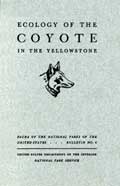.gif)
MENU
![]() Foreword
Foreword
|
Fauna of the National Parks — No. 4
Ecology of the Coyote in the Yellowstone |

|
FOREWORD
THE SUBJECT of predator-prey relationships is one of the more complex and difficult problems in the relatively new art of wildlife conservation, and is of paramount importance in any natural area, such as national parks, from which human influence is largely excluded. During the past decade special attention has been given to the role of predators, particularly coyotes, in all of the national parks of the United States. In Yellowstone National Park it was believed for many years that control of coyotes was necessary in order to preserve the antelope, bighorn, mule deer, and other ungulates. This opinion persisted even after control had been discontinued in the spring of 1935, in conformity with the Service policy that ". . . no native predator shall be destroyed on account of its normal utilization of any other park animal, excepting if that animal is in immediate danger of extermination . . ." (Wright, Dixon, Thompson, 1933, p. 47). Sentiment favoring coyote control became so strong that in March 1937, a thorough scientific study of the coyote in Yellowstone and its relation to all species upon which it feeds was authorized, in accord with the following statement of National Park Service wildlife policy, quoted from the previous reference: ". . . no management measure or other interference with biotic relationships shall be undertaken prior to a properly conducted investigation."
Field studies were begun on May 1, 1937, and continued with minor interruptions until March 7, 1939. Approximately 14 months were spent in field and laboratory study exclusive of time devoted to writing the account here published. The study represents a survey of conditions over a period of about 2 years.
I wish to express my appreciation to Arno B. Cammerer, Director of the National Park Service, for making it possible to carry on the study, and to Regional Director Thos. J. Allen, Jr., and Associate Regional Director Paul V. Brown for arranging administrative routine so as to allow me time to complete the field work and write up the results. H. C. Bryant, now Public Works Administration Consultant, Region IV, and Carl P. Russell, Victor H. Cahalane, and C. C. Presnall, all of the Branch of Research and information, have supported the study in many ways and have been a source of constant encouragement. In the field I received cooperation and many courtesies from various members of the Yellowstone National Park staff. Superintendent Edmund B. Rogers, who is interested in furthering research, supplied various facilities for the work, including access to the numerous annual and monthly reports, Nature Notes, and other official documents referred to throughout this bulletin. The brief mention of rangers and naturalists made in the text does not begin to measure the extent of their help and cooperation. I feel specially grateful to Ranger David D. Condon for the use of valuable observations made by him the winter before I began my study as well as during the progress of the study; to Assistant Park Naturalist Frank Oberhansley with whom I spent much time in the field and who worked with me on certain phases of the study; and to Rangers Rudolf Grimm and Walter Gammill who contributed many interesting observations and assistance. Arthur Olson, district ranger of the Absaroka National Forest, Gardiner, Mont., supplied me with helpful information on game conditions in the area under his jurisdiction. I also wish to express my appreciation to John Sieker, formerly supervisor of Shoshone National Forest, for opportunity to join his party on a week's field trip in the forest, where I was able to compare conditions with those in Yellowstone National Park. O. J. Murie of the Bureau of Biological Survey helped in many ways, and Martin Murie assisted in the field work during one summer.
ADOLPH MURIE.
Jackson, Wyo.
April 2, 1939.
 Top
Top
Last Modified: Thurs, Dec 20 2001 10:00:00 pm PDT
http://www.cr.nps.gov/history/online_books/fauna4/fauna0.htm
![]()
